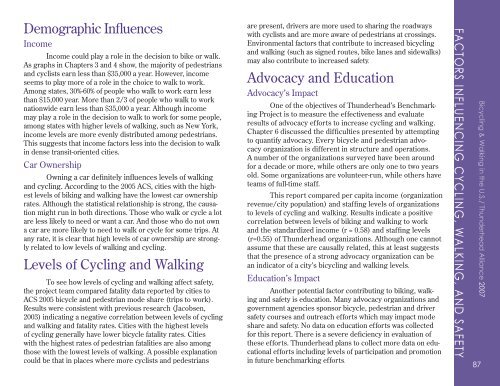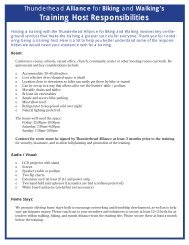2007 Benchmarking Report - Alliance for Biking & Walking
2007 Benchmarking Report - Alliance for Biking & Walking
2007 Benchmarking Report - Alliance for Biking & Walking
You also want an ePaper? Increase the reach of your titles
YUMPU automatically turns print PDFs into web optimized ePapers that Google loves.
Demographic Influences<br />
Income<br />
Income could play a role in the decision to bike or walk.<br />
As graphs in Chapters 3 and 4 show, the majority of pedestrians<br />
and cyclists earn less than $35,000 a year. However, income<br />
seems to play more of a role in the choice to walk to work.<br />
Among states, 30%-60% of people who walk to work earn less<br />
than $15,000 year. More than 2/3 of people who walk to work<br />
nationwide earn less than $35,000 a year. Although income<br />
may play a role in the decision to walk to work <strong>for</strong> some people,<br />
among states with higher levels of walking, such as New York,<br />
income levels are more evenly distributed among pedestrians.<br />
This suggests that income factors less into the decision to walk<br />
in dense transit-oriented cities.<br />
Car Ownership<br />
Owning a car definitely influences levels of walking<br />
and cycling. According to the 2005 ACS, cities with the highest<br />
levels of biking and walking have the lowest car ownership<br />
rates. Although the statistical relationship is strong, the causation<br />
might run in both directions. Those who walk or cycle a lot<br />
are less likely to need or want a car. And those who do not own<br />
a car are more likely to need to walk or cycle <strong>for</strong> some trips. At<br />
any rate, it is clear that high levels of car ownership are strongly<br />
related to low levels of walking and cycling.<br />
Levels of Cycling and <strong>Walking</strong><br />
To see how levels of cycling and walking affect safety,<br />
the project team compared fatality data reported by cities to<br />
ACS 2005 bicycle and pedestrian mode share (trips to work).<br />
Results were consistent with previous research (Jacobsen,<br />
2003) indicating a negative correlation between levels of cycling<br />
and walking and fatality rates. Cities with the highest levels<br />
of cycling generally have lower bicycle fatality rates. Cities<br />
with the highest rates of pedestrian fatalities are also among<br />
those with the lowest levels of walking. A possible explanation<br />
could be that in places where more cyclists and pedestrians<br />
are present, drivers are more used to sharing the roadways<br />
with cyclists and are more aware of pedestrians at crossings.<br />
Environmental factors that contribute to increased bicycling<br />
and walking (such as signed routes, bike lanes and sidewalks)<br />
may also contribute to increased safety.<br />
Advocacy and Education<br />
Advocacy’s Impact<br />
One of the objectives of Thunderhead’s <strong>Benchmarking</strong><br />
Project is to measure the effectiveness and evaluate<br />
results of advocacy ef<strong>for</strong>ts to increase cycling and walking.<br />
Chapter 6 discussed the difficulties presented by attempting<br />
to quantify advocacy. Every bicycle and pedestrian advocacy<br />
organization is different in structure and operations.<br />
A number of the organizations surveyed have been around<br />
<strong>for</strong> a decade or more, while others are only one to two years<br />
old. Some organizations are volunteer-run, while others have<br />
teams of full-time staff.<br />
This report compared per capita income (organization<br />
revenue/city population) and staffing levels of organizations<br />
to levels of cycling and walking. Results indicate a positive<br />
correlation between levels of biking and walking to work<br />
and the standardized income (r = 0.58) and staffing levels<br />
(r=0.55) of Thunderhead organizations. Although one cannot<br />
assume that these are causally related, this at least suggests<br />
that the presence of a strong advocacy organization can be<br />
an indicator of a city’s bicycling and walking levels.<br />
Education’s Impact<br />
Another potential factor contributing to biking, walking<br />
and safety is education. Many advocacy organizations and<br />
government agencies sponsor bicycle, pedestrian and driver<br />
safety courses and outreach ef<strong>for</strong>ts which may impact mode<br />
share and safety. No data on education ef<strong>for</strong>ts was collected<br />
<strong>for</strong> this report. There is a severe deficiency in evaluation of<br />
these ef<strong>for</strong>ts. Thunderhead plans to collect more data on educational<br />
ef<strong>for</strong>ts including levels of participation and promotion<br />
in future benchmarking ef<strong>for</strong>ts.<br />
FACTORS INFLUENCING CYCLING, WALKING, AND SAFETY<br />
87<br />
Bicycling & <strong>Walking</strong> in the U.S./ Thunderhead <strong>Alliance</strong> <strong>2007</strong>



